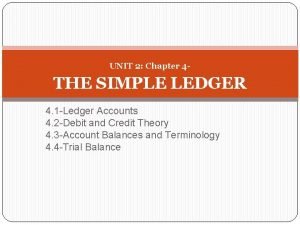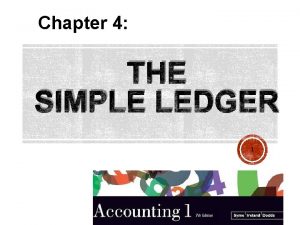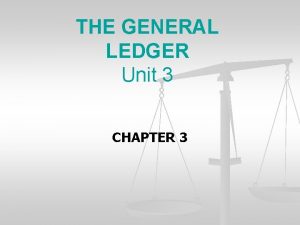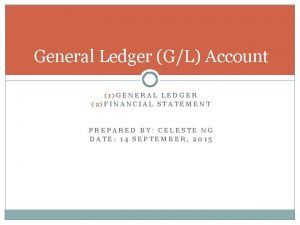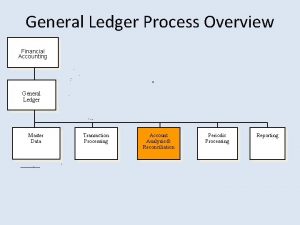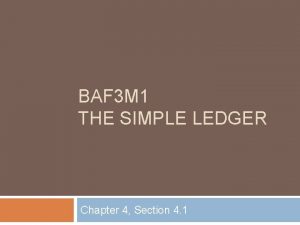UNIT 2 Chapter 4 THE SIMPLE LEDGER 4
























































- Slides: 56

UNIT 2: Chapter 4 - THE SIMPLE LEDGER 4. 1 -Ledger Accounts 4. 2 -Debit and Credit Theory 4. 3 -Account Balances and Terminology 4. 4 -Trial Balance

LEDGER ACCOUNTS Organization need to see a more specific break down of the transactions that are occurring within the organization and need to further organize that information. LEDGER ACCOUNT: Account: is a page specially designed to record the changes in each individual item affecting the financial position. Ledger: is a group or file of those individual accounts

LEDGER ACCOUNTS Each individual balance sheet item is given its own account which is record in a “T-chart” The dollar figure for each balance sheet item is recorded in the account on the first line. This is the beginning balance for the account. The ledger and the balance sheet both show financial position … if you have a ledger you can prepare a balance sheet … if you have a balance sheet you can prepare a ledger.

LEDGER ACCOUNTS Ø What is the accounting equation? equation Ø Which side of the balance sheet do you find Assets? Liabilities? Owner’s Equity? Assets Beginning $ Value Left Right = Liabilities + Owner’s Equity Beginning $ Value Left Right

Sample Company • How many accounts do you see here?

Assets Cash 3, 265 = Liabilities + Owner’s Equity Supplies Bank Loan 2, 465 18, 000 B. Rissien, Capital 60, 287 W. Caruso A/R 150 R. Van Loon A/R 620 Trucks Dini Bros. A/P 55, 075 Equipment 22, 174 1, 516 A/P Packham Products 3, 946

LEDGER ACCOUNTS IMPORTANT FEATURES WHEN CREATING “T-CHARTS”: 1. Each individual item on the Balance Sheet is considered its own account and is given its own page which is divided as a “T”. 2. The dollar figure for each item is recorded in the account in the first line. This is the beginning value. 3. It is important to record the figured on the correct side of the chart. Remember the accounting equation when doing this A=L+OE

Exercise 1 (page 82) Ø Set up the ledger for Stevens Woodworking using T- accounts.

Exercise 3 (page 83) Ø Shown below is the ledger of Lilly Wall, who operates an interior design business. Create a balance sheet as of January 31, 2008. Accounts Receivable Cash 500 2, 100 Accounts Payable 950 Supplies 1, 500 Bank Loan 2, 000 Equipment 2, 800 Lilly Wall, Capital ? ? ?

Debit & Credit Theory

Ledger Accounts ØEarlier we learned that ledger accounts have a “left side” and a “right side”. ØAccountants refer to these two sides as Debit and Credit. Assets + Owner’s Equity = Liabilities Left Right Debit Credit (DR) (CR) For ALL ACCOUNTS, the “left side” is the Debit side and the “right side” is the Credit side.

Rules of Debit and Credit ØNow that we know which side of the account is debit and which is credit, we need to know how to enter changes in the accounts. ØRULE: For each account, increases are recorded on the “beginning value” side and decreases are recorded on the opposite side. Assets Debit Credit (DR) Beginnin g $ Value (CR) = Liabilities Debit Credit (DR) (CR) Beginni ng $ Value + Owner’s Equity Debit Credit (DR) (CR) Beginni ng $ Value

Transaction Analysis Sheet

Transaction Analysis Sheet for Pacific Trucking The company purchases $200 worth of supplies from Packham Products, to be paid for later. Supplies A/P – Packham Products Asset Liabilities + + DR CR j 200– An accountant would express this transaction as: “debit Supplies and credit AP – Packham Products, $200. ”

Pacific Trucking Ledger Cash 3, 265 Supplies Bank Loan 2, 465 18, 000 150 R. Van Loon A/R 620 es ud cl e in d th al n t tio an to ac dit he ns re L t tra & c UA t e. th ebi EQ its : d d ts TE h a ebi cre NO bot l d ta to W. Caruso Trucks 55, 075 Equipment 22, 174 Capital 60, 287 j 200 A/R B. Rissien, Dini Bros. A/P 1, 516 Packham Products 3, 946 200 j ACCOUNTING ENTRY—All of the changes in the accounts caused by one business transaction, expressed in terms of debits and credits.

Transaction Analysis Sheet for Pacific Trucking The company pays $500 to Dini Bros. In partial payment of the amount owed to them. A/P – Dini Bros. Cash Liability Asset – – DR CR k 500– An accountant would express this transaction as: “debit A/P – Dini Bros and credit Cash, $500. ”

Pacific Trucking Ledger Cash 3, 265 Supplies 500 k 2, 465 j 200 W. Caruso A/R 150 R. Van Loon A/R 620 Bank Loan Trucks 55, 075 Equipment 22, 174 18, 000 B. Rissien, Capital 60, 287 Dini Bros. A/P k 500 A/P 1, 516 Packham Products 3, 946 200 j

Transaction Analysis Sheet for Pacific Trucking The company receives $200 cash from R. Van Loon in partial payment of her debt. Cash A/R – R. Van Loon Asset + – DR CR l 200– An accountant would express this transaction as: “debit Cash and credit A/R – R. Van Loon, $200. ” 18

Pacific Trucking Ledger Cash 3, 265 l 200 Supplies 500 k 2, 465 j 200 W. Caruso A/R 150 R. Van Loon 19 Trucks 55, 075 A/R 620 Bank Loan 200 l Equipment 22, 174 18, 000 B. Rissien, Capital 60, 287 Dini Bros. A/P k 500 1, 516 A/P Packham Products 3, 946 200 j

Transaction Analysis Sheet for Pacific Trucking A delivery service is provided for a customer at a price of $400. The customer pays cash at the time of the service. Cash B. Rissien, Capital Asset Owner’s Equity + + DR CR m 400– An accountant would express this transaction as: “debit Cash and credit B. Rissien, Capital, $400. ” 20

Pacific Trucking Ledger Cash 3, 265 l 200 m 400 Supplies 500 k 2, 465 j 200 W. Caruso A/R 150 R. Van Loon 21 Trucks 55, 075 A/R 620 Bank Loan 200 l Equipment 22, 174 18, 000 B. Rissien, Capital 60, 287 400 m Dini Bros. A/P k 500 A/P 1, 516 Packham Products 3, 946 200 j

Transaction Analysis Sheet for Pacific Trucking A used truck costing $8, 000 is purchased from Dini Bros. A cash down payment of $2, 500 is made at the time of the purchase and the balance is to be paid at a later date. Truck Cash A/P – Dini Bros Asset Liability + – + DR CR CR n 8, 000– n 2, 500– n 5, 500– An accountant would express this transaction as: “debit Trucks $8, 000, credit Cash $2, 500 and credit A/P – Dini Bros $5, 500. ”

Pacific Trucking Ledger Cash 3, 265 l 200 m 400 Bank Loan Notice: 18, 000 total Debits still EQUAL total. A/P Dini Trucks Credits. Bros. B. Rissien, 500 k 2, 465 2, 500 n j 200 W. Caruso A/R 150 55, 075 n 8, 000 R. Van Loon A/R 620 Supplies 200 l Equipment 22, 174 k 500 A/P 1, 516 5, 500 n Packham Products 3, 946 200 j Capital 60, 287 400 m

Transaction Analysis Sheet for Pacific Trucking A delivery service is completed for R. Van Loon at a price of $350. Van Loon does not pay for the service at the time it is provided, but agrees so pay within 60 days. A/R – R. Van Loon B. Rissien, Capital Asset Owner’s Equity + + DR CR o o 350– An accountant would express this transaction as: “debit A/R – R. Van Loon and credit B. Rissien, Capital, $350. ”

Pacific Trucking Ledger Cash 3, 265 l 200 m 400 Supplies Bank Loan 500 k 2, 465 2, 500 n j 200 W. Caruso A/R 150 R. Van Loon A/R 620 200 l o 350 Trucks 55, 075 n 8, 000 Equipment 22, 174 B. Rissien, 18, 000 Dini Bros. A/P k 500 A/P 1, 516 5, 500 n Packham Products 3, 946 200 j Capital 60, 287 400 m 350 o

Transaction Analysis Sheet for Pacific Trucking One of the lifting machines (equipment) breaks down. The company spends $650 cash to have the machine repaired. B. Rissien, Capital Cash Owner’s Equity Asset – – DR CR p p 650– An accountant would express this transaction as: “B. Rissien, Capital and credit Cash, $650. ”

Pacific Trucking Ledger Cash 3, 265 l 200 m 400 Supplies 500 k 2, 465 2, 500 n j 200 650 p W. Caruso A/R 150 Trucks 55, 075 n 8, 000 R. Van Loon A/R 620 o 350 Bank Loan 200 l Equipment 22, 174 B. Rissien, Capital 18, 000 p 650 Dini Bros. A/P k 500 A/P 1, 516 5, 500 n Packham Products 3, 946 200 j 60, 287 400 m 350 o

Double-Entry System of Accounting Ø Whenever a transaction occurs, changes must be made in the accounts. Ø All of the account changes, in a single transaction, must balance. Ø For each transaction, the total debits EQUAL the total credits.

Double-Entry System of Accounting Ø In the double-entry system of accounting every transaction is recorded in the accounts in two steps: (1) as a debit and (2) as a credit Ø At least two accounts are affected by every transaction. Ø The following is a summary of the transactions we analyzed using the “transaction analysis sheet”.

Double-Entry System of Accounting 2 2 NOTE: for each NOTE: the Debit entry NOTE: the eachentry individual transaction, is listed before theof transaction is consists the total debits Credit entry. at least Credit twoentry. accounts. EQUAL total credits 2 2 3 2 2

Exercise 3 (page 91) Flora Siska is the owner-operator of a fitness clinic. The ledger used in her business contains the following accounts: Cash; Accounts Receivable (several); Supplies; Furniture; Equipment; Automobile; Accounts Payable (several); and Flora Siska, Capital. Listed on the following page, are transactions of Flora’s business. Examine these transactions and record your analysis on a “transaction analysis sheet”. 31

Exercise 3 (continued) Transactions: 1. The business receives $300 cash from J. Parker, one of the debtors. 2. The business purchases $200 worth of supplies for cash. 3. Little Bros. , one of the creditors, is paid $100. 4. The owner withdraws $250 for her personal use. 5. A new piece of equipment costing $500 is purchased from Champion Sports. The business pays $125 cash at the time of purchase, with the balance due within 30 days. 6. A new customer signs up for a fitness course. The $300 fee is paid in cash. 32

Exercise 4 (page 92) Crooks Garage is a small business operated by James Crooks. Shown, are 10 selected transactions of Crooks Garage. Analyze these transactions on a “transaction analysis sheet”. When performing your analysis, choose from the following accounts: Cash; Accounts Receivable (several); Supplies; Equipment; Truck; Bank Loan; Accounts Payable (several); and J. Crooks, Capital. 33

Exercise 4 (continued) Transactions: 1. A car is repaired for a customer who pays the $450 charge in cash. 2. The business purchases $170 of supplies for cash. 3. The business pays $125 to Rossi Co. , an account payable. 4. The business receives $90 from G. Rawl, an account receivable. 5. A welding unit, included in the equipment account at $500, is run over by a truck. It is so badly damaged that it has to be thrown away. 6. A new welding unit is purchased on credit from Bly Co. at a cost of $790. 7. For the repair of his car, F. Stefryk pays $100 cash and owes $250, the balance of the repair charge. 8. Arrangements are made with the bank to borrow $6, 000. A promissory note for this amount is signed by Mr. Crooks for the bank, after which the bank provides the business with $6, 000 cash. 9. Albert Mc. Cann, a mechanic employed by Crooks Garage, is paid wages of $375. 10. A towing service is performed for a customer for $40 cash. 34

Account Balances and Terminology

Pacific Trucking Ledger Cash Supplies Bank Loan B. Rissien, Draw a line to Capital signify “a total” 500 k 2, 465 3, 265 18, 000 2, 500 n j 200 l 200 p 650 60, 287 650 p m 400 2, 66 Total 0 the debits and the 400 m A/P Dini 2, 665 3, 86 3, 65 5 credits … these are 350 o Bros. 5215 0 known as “pencil 65 61, 03 k 500 1, 516 Trucks footings” 0 60, 387 7 A/R W. 5, 500 n 55, 075 Caruso 50 7, 01 n 8, 000 150 Circle to signify 6, 516 0 63, 07 Subtract the “smaller” number “account balance” 63, 075 5 from the. A/R “larger”R. and record the A/P Packham Products difference as the “account Van Loon Equipment balance” beneath the “larger” 3, 946 200 l 620 number 22, 174 200 j o 350 0 4, 14 97 200 4, 146 6 770 0 36

Interpreting the Account Balance ü Normally, we can determine the type of account from the balance. v. For example, Cash has a debit balance, assets have debit balances, therefore, Cash is an asset. The opposite would also be true … Cash is an asset account, therefore, it should have a debit balance. ü What can you say about liabilities? owner’s equity?

Interpreting the Account Balance ü Exceptions to the rule: v. A creditor overpays v. Bank account becomes over-drawn v. Overpay a debtor v. A customer, who does not have an A/R balance, returns some merchandise v. You return good to a supplier whom you currently have no A/P balance ü Exceptional balances do not last long. Ordinary business activity usually causes them to return quickly to “normal”.

Terminology: Bank vs. Cash ü Businesses rely heavily on the banking system. ü The most common ways to make payment are by cheque and electronic funds transfer. ü You can expect to see an account called Bank rather than Cash. ü The words “bank” and “cash” are often used interchangeably. v. For example, when an accountant describes an item as bought for cash, this means that it is paid for at the time it is purchased. The payment is generally made by cheque and not by actual cash.

Terminology: Buying and Selling on Credit ü Businesses with good reputations are able to buy goods on short-term credit. ü The purchaser is able to delay payment for a short period of time, usually 30 days. ü The purchaser thus has time to inspect or test the goods thoroughly before paying for the. ü If you are the purchaser, which account would this affect?

Terminology: On Account ü The term “on account” account is an essential part of business vocabulary. The term is used in four specific ways: v. If an item is purchased on account it is not paid for at the time of purchase. v. A sale on account is a sale for which the money is not received until a later date. v. A payment on account is money paid to a creditor to reduce the amount owed to that creditor. v. A receipt on account is money received from a debtor to reduce the amount owed by that debtor.

Exercise 1 (page 96) Calculate the balances for the following accounts: A/R H. Devrie Cash 250 1, 210 360 29 190 48 512 25 150 70 35 A/P P. Helka 175 30 45 75 40 175 R. Smart, Capital 150 3, 140 A. What does the debit balance in the H. Devrie account mean? B. What does the credit balance in the P. Helka account mean?

Exercise 2 (page 96) The following three accounts have exceptional balances. Examine them and answer the questions that follow. A/R P. Chu Cash 500 A/P J. Reicher 100 300 A. For each account, explain what is unusual about the balance. B. For each account, give a possible cause of the exceptional balance. 43

Trial Balance

Keeping things in Balance Ø When setting up a ledger the information for the accounts is usually obtained from a balance sheet. Ø This ensures that the ledger begins in balance … total of the accounts with debit balances equals the total of accounts with credit balances. Ø Business transactions are recorded in the ledger. Each transaction forms a balanced account entry … total debits equal total credits.

Trial Balance Ø Periodically, it is necessary to check the accuracy of the ledger. Ø To ensure that everything is in balance we can “take off” a trial balance Ø A trial balance is a listing of the account balances in the ledger. Ø A trial balance compares the total of the accounts with debit balances with the total of accounts with credit balances.

Trial Balance Ø If the total debits agree with the total credits, the ledger is said to be in balance Ø If they don’t agree, the ledger is said to be out of balance Ø In a manual accounting system the whole process, called taking off a trial balance, balance is usually done weekly or monthly.

Pacific Trucking Ledger Assets Cash 3, 265 l 200 m 400 3, 86 5215 Supplies 500 k 2, 465 2, 500 n j 200 650 p 2, 66 0 2, 665 3, 65 5 0 Trucks W. Caruso A/R 150 R. Van Loon A/R 620 o 350 97 0770 = Liabilities + Owner’s Equity 200 l 200 55, 075 n 8, 000 63, 075 5 Bank Loan Equipment Capital 18, 000 60, 287 400 m 350 o 65 61, 03 0 60, 387 7 p 650 Dini Bros. A/P k 500 50 0 B. Rissien, 0 A/P 1, 516 5, 500 n 7, 01 6, 516 6 Packham Products 22, 174 0 3, 946 200 j 4, 146 6

Steps for Taking Off a Trial Balance 1. List all the accounts and their balances. 2. 3. 4. 5. Leave room for a three-line heading. Place the debit balances in a debit column and the credit balances in a credit column. Add up the two columns. See if the two column totals are the same. Only if the two column totals are the same can you consider your ledger work to be correct. Write a heading at the top. A heading is necessary on the trial balance. It must show “Who”, “What”, and “When.

Trial Balance Step 1: Write Title (Who, What, & When) Step 2: List Accounts Step 4: Total Columns Step 3: Enter debit & credit balances

Trial Balance

Importance of Trial Balance ØIt is important to an accountant to have the ledger in balance. ØA trial balance that is out of balance is a certain sign of at least one error in the accounts.

Trial Balance Out of Balance ØPossible problems: üFaulty addition üEntering an item on the wrong side üDollar value entry error ØEven if the ledger is in balance, it might still have errors.

Trial Balance Out of Balance ØA ledger that is in balance may only be mechanically or mathematically correct. ØThe accountant may have made incorrect, balanced entries.

Trial Balance Out of Balance Ø To find errors, there is a four-step procedure: Step 1 Re-add the trial balance. Step 2 Check the figures from the ledger against those of the trial balance. Make sure that none are missing, none are on the wrong side, and none are for the wrong amount. Step 3 Recalculate the account balances. Step 4 Check that there is a balanced accounting entry in the accounts for each transaction.

TO DO: ØP. 102 – Exercise 2 ØP. 103 – Exercise 3
 T charts accounting
T charts accounting Chapter 4 the simple ledger answers
Chapter 4 the simple ledger answers Chapter 4 posting to a general ledger
Chapter 4 posting to a general ledger Post. ref. accounting
Post. ref. accounting Unit 10, unit 10 review tests, unit 10 general test
Unit 10, unit 10 review tests, unit 10 general test Hát kết hợp bộ gõ cơ thể
Hát kết hợp bộ gõ cơ thể Frameset trong html5
Frameset trong html5 Bổ thể
Bổ thể Tỉ lệ cơ thể trẻ em
Tỉ lệ cơ thể trẻ em Chó sói
Chó sói Chụp tư thế worms-breton
Chụp tư thế worms-breton Chúa yêu trần thế
Chúa yêu trần thế Các môn thể thao bắt đầu bằng tiếng bóng
Các môn thể thao bắt đầu bằng tiếng bóng Thế nào là hệ số cao nhất
Thế nào là hệ số cao nhất Các châu lục và đại dương trên thế giới
Các châu lục và đại dương trên thế giới Công thức tính độ biến thiên đông lượng
Công thức tính độ biến thiên đông lượng Trời xanh đây là của chúng ta thể thơ
Trời xanh đây là của chúng ta thể thơ Mật thư anh em như thể tay chân
Mật thư anh em như thể tay chân 101012 bằng
101012 bằng độ dài liên kết
độ dài liên kết Các châu lục và đại dương trên thế giới
Các châu lục và đại dương trên thế giới Thơ thất ngôn tứ tuyệt đường luật
Thơ thất ngôn tứ tuyệt đường luật Quá trình desamine hóa có thể tạo ra
Quá trình desamine hóa có thể tạo ra Một số thể thơ truyền thống
Một số thể thơ truyền thống Cái miệng nó xinh thế chỉ nói điều hay thôi
Cái miệng nó xinh thế chỉ nói điều hay thôi Vẽ hình chiếu vuông góc của vật thể sau
Vẽ hình chiếu vuông góc của vật thể sau Nguyên nhân của sự mỏi cơ sinh 8
Nguyên nhân của sự mỏi cơ sinh 8 đặc điểm cơ thể của người tối cổ
đặc điểm cơ thể của người tối cổ V. c c
V. c c Vẽ hình chiếu đứng bằng cạnh của vật thể
Vẽ hình chiếu đứng bằng cạnh của vật thể Phối cảnh
Phối cảnh Thẻ vin
Thẻ vin đại từ thay thế
đại từ thay thế điện thế nghỉ
điện thế nghỉ Tư thế ngồi viết
Tư thế ngồi viết Diễn thế sinh thái là
Diễn thế sinh thái là Dạng đột biến một nhiễm là
Dạng đột biến một nhiễm là Bảng số nguyên tố lớn hơn 1000
Bảng số nguyên tố lớn hơn 1000 Tư thế ngồi viết
Tư thế ngồi viết Lời thề hippocrates
Lời thề hippocrates Thiếu nhi thế giới liên hoan
Thiếu nhi thế giới liên hoan ưu thế lai là gì
ưu thế lai là gì Hổ sinh sản vào mùa nào
Hổ sinh sản vào mùa nào Sự nuôi và dạy con của hươu
Sự nuôi và dạy con của hươu Sơ đồ cơ thể người
Sơ đồ cơ thể người Từ ngữ thể hiện lòng nhân hậu
Từ ngữ thể hiện lòng nhân hậu Thế nào là mạng điện lắp đặt kiểu nổi
Thế nào là mạng điện lắp đặt kiểu nổi Simple present, simple past simple future examples
Simple present, simple past simple future examples Present simple past simple future simple
Present simple past simple future simple Present simple present continuous past simple future simple
Present simple present continuous past simple future simple Past simple future
Past simple future Simple past simple present simple future
Simple past simple present simple future Continuous future in the past
Continuous future in the past Walk simple past tense
Walk simple past tense Definition present simple
Definition present simple Present simple present continuous 4 класс
Present simple present continuous 4 класс What is consumable stores in accounting
What is consumable stores in accounting
